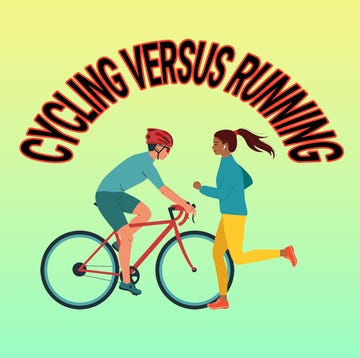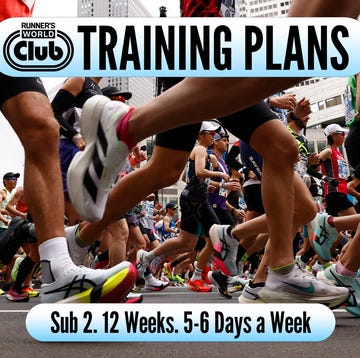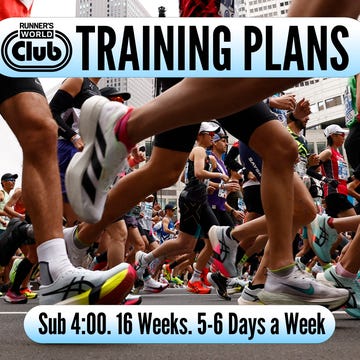By no means a single-speed activity, running can mean slower, sociable outings where you can enjoy conversations, as well as faster, snappier efforts where you can barely catch your breath – and everything in between. In fact, running can encompasses all paces, efforts and distances and building a range of sessions into your own training routine not only adds variety to your weeks, but also helps to transform you into a fitter and stronger runner.
But if you feel confused by all the different types of runs, don’t know which runs are the most important and have no idea how to execute each workout properly, you’ve arrived at the right place. Here, we’ve identified all the key runs that you should incorporate into your training schedule – and how to get the maximum benefit from each.
1. Long runs
As the name implies, long runs are the longest runs on your weekly schedule – but the actual distance will vary depending on your target race distance. For example, if you’re training for a 5K, your longest run might be three miles to start, but if you’re training for a marathon, you could work all the way up to a 22-mile long run.
What everyone's reading
Your pace for your long run will also vary depending on your fitness level and goals. In general, though, you should be able to complete long runs at a conversational pace, which means that you could chat with your running buddy the entire time and breathe naturally.
Benefits of long runs
These runs will improve your aerobic fitness and endurance, helping you to become a more efficient runner. Long runs also assist in strengthening your slow-twitch muscle fibres, which help to stave off fatigue in the later miles of a run or race.
2. Recovery runs
Recovery runs should also be done at your conversational pace. They serve as an important part of any training plan, because – as the name indicates – they help your body to recover from the harder runs in your schedule. The tricky part is finding your ideal pace, as many runners tend to clock these workouts a little too fast.
Essentially, a recovery run is short in duration and practiced at a lower intensity than your other workouts. This means that you should be running at less than 70% of your maximum heart rate.
Benefits of easy runs
Recovery runs improve cardiovascular and muscular development, which means that they’ll help you to boost your overall fitness and safely increase your mileage week after week – and building weekly mileage is crucial for boosting endurance.
3. Hill repeats
Hill repeats involve running uphill, again and again, which means that you’re going to really work your leg muscles during this type of run. If there aren’t any hills in your area, don’t worry – you can still practice hill repeats on a treadmill.
Although these workouts are meant to challenge you, this doesn’t mean that you must sprint them. Again, your goals and fitness level will determine the speed at which you tackle hills – crucially, though, you want to learn to maintain your pace throughout the whole climb, rather than fizzle out halfway through.
Benefits of hill repeats
Hill repeats help you to build strength and power in your lower body and improve your running economy, which means that you’ll be able to run more efficiently.
4. Interval runs
Intervals are short, intense efforts followed by equal or slightly longer blocks of recovery time. For example, after a warm-up, you could run two minutes at a hard effort, followed by two to three minutes of easy jogging or walking to catch your breath. It might also mean running a hard 400m, followed by a 200m walk or jog.
Most often, you’ll perform the work periods of interval runs at an effort that’s in the red – as in, you’re breathing heavily, unable to hold a conversation and counting the seconds until you can stop. It should be a controlled, fast effort followed by a truly easy jog or walk.
The secret to interval success is in the recovery. If you’re patient and disciplined while you’re running easy, you’ll be able to run strong for the next interval and finish the entire workout feeling fatigued but not completely exhausted. Another key to conquering intervals is to not do the first repetition so fast that you’re already spent by the time that you do the last.
Benefits of interval runs
By doing interval runs, you’ll improve your running form and economy, endurance, mind-body coordination, motivation and possibly even your body’s ability to burn fat. Interval runs are the real key to running faster and, when done at maximum effort, help to increase your VO2 max as well.
5. Tempo runs
Tempo runs are like a sandwich, where the warm-up and cooldown are the slices of bread and your filling is a run where you’re working at an effort that’s equal to – or slightly above – your anaerobic threshold. (Your anaerobic threshold is the point at which your body must switch to generating energy without sufficient oxygen.) This effort level sits just outside your comfort zone, where you can hear your breathing, but you’re not gasping for air.
If you can talk easily, you’re not yet in the tempo zone. If you can’t talk at all, you’re above it. So, tempo runs should be done at an effort that’s somewhere in the middle – a ‘comfortably hard’ effort that allows you to talk in broken words and hold that effort for at least 20 minutes.
Instead of looking at pace, which can be affected by variables like heat, wind, fatigue and terrain, look at effort during a tempo run. You should try to hold a steady effort throughout.
If you’re following a training place, you will almost certainly see tempo paces suggested within it – especially if your plan is focused on helping you to break a time barrier. In this case, the tempo efforts are usually slightly faster than your goal race pace if you’re preparing for a half marathon or marathon, but slightly slower than goal race pace if you’re training for something like a 5K. You’ll often see them sandwiched into long runs, too.
Benefits of tempo runs
Tempo runs are great for race simulation and help to increase your lactate threshold, which means that you can faster at an easier effort. They improve your focus and mental strength, too, giving you confidence you can hit your goal pace on race day.
6. Threshold runs
Tempo runs and threshold runs often get lumped together. You may run tempos right around your lactate threshold pace, which is the point at which your body can no longer clear lactate – a byproduct of exercise – and you fatigue. Threshold training, meanwhile, is a little more precise and often a little more intense.
In many cases, you’ll do tempo runs based on feel, but threshold runs typically require more planning and ask you to figure out your speed when you hit your lactate threshold. Once you have identified that pace, you can incorporate it into longer interval workouts and even mix it into quality long runs.
Benefits of threshold runs
Just like tempo runs, threshold runs help to raise the ceiling on your lactate threshold, allowing you to run at a faster pace for a longer period of time. They also train you mentally to get comfortable with being uncomfortable – a skill that you’ll need to earn a PB on race day.
7. Progression runs
Progression runs, as they imply, progressively get faster throughout the run. So long as you abide by this rule, you can structure your workout however you like. This means that even if you end at a pace that’s five seconds faster than when you started, it still qualifies as a progression run.
You also don’t have to focus solely on your running pace for a progression run – tracking your perceived effort is just as effective when it comes to executing this type of run.
Most often, progression runs are done at a tempo effort – again, that’s a ‘comfortably hard’ effort – or pace. However, they’re mostly about not starting out too rapidly so that you can finish faster.
Benefits of progression runs
Progression runs are hugely beneficial in that they teach you about pacing – they help you to avoid going out too fast in races by giving you a chance to learn how to control your speed. In addition, progression runs help you to run faster for longer and improve your confidence for race day.
8. Fartlek runs
Fartleks are not only fun to say out loud, but also fun to do. Fartlek is the Swedish word for ‘speed play’, which is exactly what this type of run is all about. Unlike tempo runs and more structured interval work, fartlek runs are unstructured and alternate between easy efforts and moderate to hard efforts.
After a warm-up, play with speed by running at faster efforts for short periods of time – to that tree or to that sign, for instance – and follow these up with easy running efforts to recover. It’s a fun type of run to do in a group setting, as you can alternate the leader and mix up the pace and time. In doing so, you can also reap the mental benefits of being pushed by others in a lively, unpredictable workout setting.
If you’re running solo, you can also use a fartlek run as a playful way to pass some time, where you target random markers as finish lines for the hard efforts. The goal is to keep it free-flowing and run to effort rather than pace, which means that you’re chained to neither your running watch nor a fixed plan.
Benefits of fartlek runs
With fartlek runs, you get stress-free workouts that improve your mind-body awareness, mental strength, stamina and pace. Fartleks are especially beneficial for newer runners who need an introduction to speed sessions, or more experienced runners who want to switch things up.















